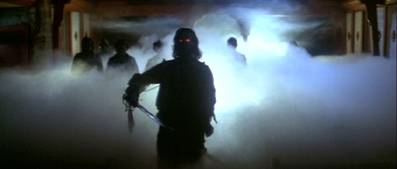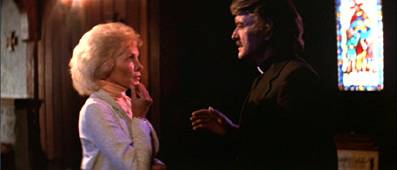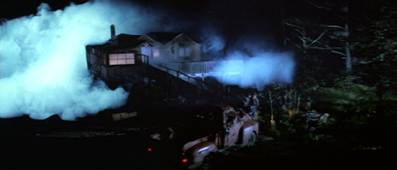|
My
first viewing of John Carpenter's The Fog,
his fourth theatrical feature as director, was at a special
preview at London's National Film Theatre. This was an exciting
moment for me – I'd just completed my film school dissertation
on Carpenter's earlier work (which included his criminally unseen
TV movie Highrise / Someone's Watching Me) and was finally, for
the first time in a year, able to sit back and watch one
of his films without a notebook in my hands. But the real
thrill was a simple one – it was a new film from the man
who had made Dark Star, Assault
on Precinct 13 and Halloween.
As the lights went down I could not have been more excited.
Listening
to the audience as we filed out of the screening was interesting.
The single most common remark was this: "It's a shame
it didn't stick to the book." Now for those coming
to the film from a 2005 perspective, this needs some explanation.
Although Carpenter's film wasn't based on a novel, its title
and timing were, for a UK audience, a little unfortunate.
The preceding six years had seen the almost meteoric rise
in popularity of horror author James Herbert,
whose first novel, The Rats, was published in 1974
and was a major best-seller, at least in the UK. He followed
up on its success the following year with an equally popular
horror story, which also took place in recognisably English
locations. It's title? The Fog. Ah, now you see the
problem. By 1980, when Carpenter's film had its preview
screening and subsequent release, James Herbert's name was far more
widely recognised in the UK than that of this young director,
and his work had reached a much larger audience here. Many of
those attending that screening may well have known who Carpenter
was, but in those pre-internet days and without the advantage
of press and review information, all they had was a title
and, if they'd done their research, a hint of a plot and
a few publicity stills (I still have them, and the original
poster, as it happens). A good part of this audience had come to see what this young American director
had done with this hugely popular English horror novel,
and as far as many of them were concerned he had simply
nicked the title and gone his own sweet way with the stpry and characters, in the process betraying
Herbert's original vision. Which, of course, was completely wrong.
Carpenter's film was made independently and quite probably
without any knowledge of Herbert's book. But before I come
across as all superior to these mistaken folk, I should
mention that I too had gone in expecting such an adaptation...

It's
in situations like this that second viewings prove so valuable,
and it was then that I was better able to appreciate the considerable
qualities of Carpenter's rural ghost story, as well as the
compromises made to ambition that supplied the first hints
of the problems that were to dog some of his later
films. But I've seen The
Fog something like twenty times since then and
I still have the original poster on my wall, so something
about it clearly works for me.
It
starts on a quote from Edgar Allen Poe and a scope-framed
close-up of a dangling pocket watch, which pans to include
a watching child lit by the flicker of firelight. It's
then that we get the movie's first jolt as a hand appears
and loudly snaps the watch shut. And you know what? This
ONLY works in the cinema. Maybe it's a scale thing, as at the preview screening everybody in the audience jumped, but
on video or DVD it's just not that startling, no cinematic
'boo' of the sort that peppered Halloween.
It matters not. This is the film's prologue, delivered by an old sea
captain played by veteran producer/actor and one-time Orson
Welles collaborator John Houseman, who sits by a camp
fire and tells a group of assembled local kids one last
tale before the clock strikes midnight. In hushed tones he relates the story of The
Elizabeth Dane, a sunken ship whose ghostly crew will one
day rise from the sea, shrouded by the fog that led to their
shipwreck exactly one hundred years ago. Up drifts the camera
and we're into the title sequence.
For Carpenter this was a break with his own main title tradition. Where in
previous films the opening credits were short, effecient
and were concluded before the film itself got under way, here they
run for several minutes over brief vignettes that suggest
unnatural things are afoot in the seaside town of Antonio
Bay. Shortly after the film's release. I remember a letter
to a film magazine complaining that they seemed to go on
forever and that the writer had been tempted to leap to
his feet and scream "Enough, already!" I know
where he's coming from, but that's still a bit much. Lengthy
though the sequence is, it's beautifully shot and edited,
but does give us our first taste of a seemingly improvised internal logic that shifts as
the story progresses. Car alarms go off, a petrol pump flies
out of its housing and starts pouring fuel onto the
ground, a TV switches itself on, a chair scurries across
a bedroom... We are approaching the 100 year anniversary
of the founding of the town and the Elizabeth Dane crew
are set to return, and this is clearly pointing the way
to the bad supernatural things that are soon to occur. But what is
actually happening here? A pre-haunting spiritual shockwave?
The only link between these incidents is that objects do things
by themselves, and that itself is clearly designed to be seen as creepy. It doesn't
really tie up with later events because it's probably not meant to,
its only purpose being to make us realise something is up, a shortcut
route to spookville via previous tales of the unnatural.
Why does a chair move across Sandy's bedroom? Because a
chest of drawers did so in The Exorcist,
and furniture that shuttles along under its own steam is
now a sure sign that something evil is at work.
This
does tend to highlight Carpenter's slightly schizophrenic approach
to certain elements in his tale of ghostly terror. Asked on the
film's release about the intimidating solidity of his ghosts,
he memorably remarked that he had to find a way to make
them scary because "we all know they don't exist."
But although he largely trades on the physical threat they
represent, he cannot resist throwing in a few of the more
traditional examples of cinematic supernaturalism. Thus a coin
transforms into a portion of the Elizabeth Dane's nameplate,
then leaks seawater over a tape recorder, then displays
a warning, then bursts into flames. Bottles shake on supermarket
shelves, van windows explode for no reason other than to
freak out its occupants and make us all jump, and a ghostly scouting party turn up the night before the anniversary at the home of the vehicle's driver and knock ominously on his door, all ready to duff him
over, only to run out of time when the clock strikes 1.00am
and its face shatters.

The significance of the title becomes apparent when it is
clearly shown that the Elizabeth Dane ghosts can only move around
within the confines of the fog, and if you stay out of it then
you should theoretically be fine. But if we return to the logic of the opening
credit sequence then they could theoretically strike at you from a distance
by throwing a chair at you or blasting you with glass, a sort of spiritual
slaughter by remote control. Does it matter? Not that much.
It is, after all, a ghost story, and Carpenter himself has
stated that if you're dealing with with the surpernatural then there are no real rules. Perhaps he's
right, but non-existent threats are the backbone of horror,
and even the wildest of tales have to function within their
own internal logic, and The Fog does sometimes
wander outside of the boundaries it sets up. It saves its biggest cheat for the end, when
a little bit of fog sneaks back into a church, unseen by
those standing outside, in order to polish off a dangling
narrative stand and provide a bloody good final shudder,
sneaking the ghosts under the door when they previously had
to either knock and wait or tear away the wood to gain entry
to an abode.
Carpenter
was clearly attempting for an expansion of scale on Halloween's
almost one-on-one conflict, in the setting, the characters and
the nature of the threat. It's an ambitious move, as it involves
geographically distancing his characters from each other,
which risks diluting the menace through the need to repeatedly
shift between them when the going gets scary. To a certain extent this is exactly
what happens, resulting in potentially hair-tearing scenes
in which the audience is let off the hook by the perveived need to cut away as tension peaks to check how the other characters are doing.
This may work as a leave-you-wondering wind-up, but does mean that the film never generates the level of unrelenting terror
found in the final twenty minutes of Halloween
because we never feel trapped in one place with no obvious escape route.
But
in other areas, the film marked very positive new ground for
the director. The amusing exchanges between the girls in
Halloween is taken several stages further
here with what for my money remains the writer-director's wittiest script, one that bristles with character detail and sassy dialogue, an
absolute gift to a cast of largely Carpenter regulars who
spark off each other beautifully. This dialogue/delivery
combo proves an essential element in engaging us with such
a wide selection of characters in a short space
of time. Even those in smaller parts get their chance to
shine – the early scene aboard The Sea Grass with three
half-drunk fisherman, for example, is a delightfully written
and performed slice of character creation and plot development.
All who know the film will remember the "Hey, there's
a fog bank out there" moment, but even if I quoted all of this sequence's dialogue here, it wouldn't come
close to reproducing how funnily it plays. But
this is comedy with purpose – by rendering these characters so
instantly likeable, their deaths at the hands of the invading
ghosts a short while later adds emotional weight to the
narrative advancement. Thus, we become involved with the characters
and their predicament from an early stage, and if their
locational disparity de-intensifies the threat, we remain
sympathetic to their plight throughout for the very simple
reason that we like them.

While the actors and script bring the characters to life, it's the skill and inventiveness of the filmmakers that
lifts The Fog way above the potential constrictions
of its budget. Dean Cundey's gorgeous scope cinematography and some excellent location work (the lighthouse that you
have to walk down to is a particularly memorable) give the
film a visual quality that most studio films would die for.
The sound effects and mix are up there with the work of
David Lynch and Alan Splet, and Carpenter's camera placement
and Tommy Lee Wallace and Charles Bornstein's editing milk
tension even from more generically familiar sequences (the
car that only becomes stuck in the mud when the occupants
are being approached by monsters, for example). Sealing
the deal is Carpenter's typically memorable score, the atmospheric synthesiser
tinklings and sinister hums later giving way to thunderous
electronic crashes and shrieks that recall sound effects
from Robert Wise's The Haunting and the
iconic strings that accompanied the assault on Janet Leigh
(also in the cast here, of course) in Psycho.
The
Fog has stood the test of time well and still
stands as a creepy, stylish and wonderfully witty horror story.
Carpenter talks on the commentary of expectations for
a film that was even more frightening than Halloween,
and on the score the film certainly falls short, despite
some nicely done scares and a couple of very well executed wind-ups.
But on all other fronts this is Carpenter on fine form,
and I'm willing to bet serious money that it craps all over
the upcoming and unwelcome remake.
The anamorphic
2.35:1 transfer here does justice to Dean Cundey's
compositions, exhibiting as it does first rate contrast,
colour and an impressive level of detail throughout. The
blacks are absolutely rock solid, as they should be given
Debra Hill's comment on the commentary about Cundey's skill at getting
the black levels dead right. There are some visible compression
artefacts on blue skies in the daytime scenes and what looks
occasionally like a teeny bit of edge enhancement, but otherwise
this is a nice job.
The
5.1 soundtrack is crystal clear but sits almost exclusively
at the front, though with some subtle but effective separation.
A little bit of LFE work during the bass tones of the music
is welcome. The original mono track has also been included,
plus a French mono dub.
It
should be noted that this is a dual-sided disk, and on side
2 is a cropped 4:3 version of the film which is a complete
mess – the print quality is OK, but not only are Dean Cundey's
compositions completely buggered up, but the editing rhythm
has been altered in order to cover characters located on alternate sides of the scope frame. Horrible.
A
John Carpenter Commentary is always
good news, and here he is joined by producer and one-time
partner Debra Hill, and the two provide an entertaining
and informative trip through the making of the film, laced
with some enjoyable anecdotal stories, my favourite being
Carpenter's tales of seasickness woe which resulted in "the
script supervisor and I blowing our lunch all over the place."
There
are two Documentaries on the making
of the film.
Tales From the Mist – Inside 'The
Fog' (27:55) is a retrospective look back
at the production, created for this DVD release and made
up primarily from interviews with cast and crew members,
including Carpenter, Hill, Tommy Lee Wallace, Dean Cundey,
Adrienne Barbeau and Janet Leigh. Carpenter and Hill repeat
the story they tell in the commentary of the genesis of
the film, which occurred in a trip to Stonehenge, located
in the same country that gave birth to the book a few of
us once thought the film was based on (spooky, huh? I thought
not). Carpenter is surprisingly damning of the first cut
of the film, which was fixed by re-shoots and a serious
re-edit. A breezily paced and enjoyable inclusion.
Fear
on Film – Inside 'The Fog' (7:41) is an original
1980 featurette and includes interviews with Carpenter,
Hill and cast members, which makes an interesting comparison
with how they look over 20 years on in the more recent documentary,
which included snippets from this one.
The
Outtakes (4:08) are not anamorphic
but are in their correct aspect ratio and in surprisingly
good shape. This has the look of a gag reel created for
the cast and crew (I've seen enough of these to recognise
the signs) and has some fun stuff in there, though there
are no real howlers.
Storyboard
to Film Comparison (1:25) covers the scene
in which the Sea Grass crew first encounter the ghosts.
Advertising gallery includes the
Theatrical Trailer (2:50), 2
Teaser Trailers (0:52 and 0:51),
3 TV Spots (0:31, 0:31 and 0:30) and slideshows
of Original Posters and Film
Memorabilia (only 3 inclusions here). The
trailer and TV spots are 4:3 and assaulted with dust damage
and scratches, and the teaser trailers appear to be from
VHS recordings, but all are valuable inclusions.
Finally the Photo Gallery has
46 behind-the-scenes and 17 publicity stills, all reproduced
at a decent size.
But
hang on, there's also an Easter Egg
here. On the Special Features menu, use the remote control
to move up above the commentary on/off selector and a pair
of glowing red eyes will appear. Select this and you get
a Montage (2:39) of tops and tails
from shots in the film showing the crew creating fog effects,
plus a sprinkling of process shots in production, all set
to the closing theme.
The
Fog's
appearance on DVD gave those of us who enjoyed it in the
cinema and then spent years groaning at its treatment on
TV a chance to really re-appreciate what a good-looking
and smart little film it is. More recently, this same package
was released on region 2 with the extra features spread
onto a second disk, and you can find it seriously discounted
on-line. Carpenter fans will already have it, but with the
take-the-money-and-run remake about to hit cinemas, this
should be considered an essential purchase for all discerning
horror fans.
|